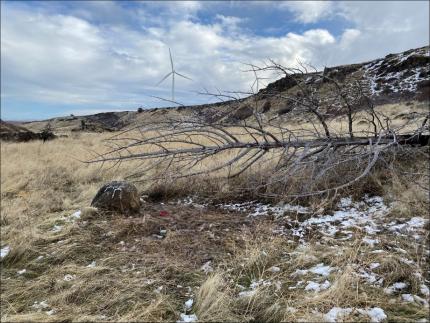Managing Wildlife Populations
Columbian White-tailed Deer Surveys: Biologists Stephens and Holman along with Wildlife Conflict Specialist Aubrey completed four Columbian white-tailed deer surveys on Puget Island during the months of November and December. These surveys are conducted in partnership with the U.S. Fish and Wildlife Service (USFWS), Oregon Department of Fish and Wildlife, and the Cowlitz Tribe. The surveys estimate population productivity by providing a fawn to doe ratio while also generating a minimum count of deer at various sites within the Columbia River sub-population. A high count of 202 deer were observed on the Dec. 20 survey. The pooled fawn to doe ratio for the surveys was 41 per 100 and the buck to doe ratio was 39 per 100. The data was submitted to USFWS and will be combined with information from other survey areas in both Washington and Oregon. Thanks to Habitat Biologist Salter and Conflict Technician Kolenberg who participated in the surveys as well.


Dusky Canada Goose Survey: Biologist Wickhem conducted a dusky Canada goose survey on the Shillapoo Wildlife Area and surrounding lowlands of Clark County the first week of January. Dusky geese are a sub-species of Canada goose that spend summers in Alaska and migrate through the lower Columbia River in the winter. Dusky geese are closed to recreational harvest due to low population levels. The purpose of the surveys is to count dusky geese observed and read alphanumeric codes on any red-collared geese. Wildlife managers survey the geese multiple times across their primary wintering grounds and use the data to generate survival estimates. On this survey, Wickhem recorded 91 geese and read one neck collar. Other notable sightings included a few swans, red-tailed hawks, northern harriers, bald eagles, great blue herons, egrets, sandhill cranes and snow geese and many species of waterfowl. Wickhem spoke with a few duck hunters who were having good success. The recent rain has filled the wetlands, which is great for all the residents of the wildlife area.

Klickitat Mule Deer Mortality Investigation: Biologist Wickhem went on a mortality investigation and collar retrieval for the first week of the new year. The doe was located on a plateau amongst the wind turbines in Eastern Klickitat County and had been scavenged by the time she arrived. All that remained was deer hair, part of the skull, and a portion of a lung which was strange to encounter considering the rest of the carcass was so heavily scavenged. Coyotes and raptors appeared to be the main scavengers, but without any sufficient deer remains, it was impossible to determine the cause of death. This doe is part of a four-year study being conducted throughout Game Management Units (GMU) 388 and 382 to track the annual movements of female mule deer and locate important migration corridors. Staff members are also attempting to determine cause of death when an animal dies, which has proven to be difficult. In the winter of 2021, 81 collars were deployed throughout GMUs for this effort. Twenty-two collars were deployed in the winter of 2022, most of which were redeployments replacing study deer that died over the first year of the study. This collar, along with others retrieved in 2022, will be redeployed in the winter of 2023.


Providing Conflict Prevention and Education
Public Outreach at Ridgefield Elementary School: Wildlife Conflict Technician Kolenberg spent Friday morning at Ridgefield Elementary School’s fourth grade career day. Kolenberg spent time talking with groups of students about his career working with wildlife as relates to securing attractants, recreating safely in bear and cougar country, and answering questions about wildlife in Washington. Kolenberg gave out educational material such as Bearwise and Living in Cougar Country brochures as well as Washington wildlife trading cards.

Treponeme-Associated Hoof Disease Elk Response: Wildlife Conflict Specialist Aubrey and Biologist Stephens responded to a report of an elk in a backyard that was no longer mobile. The reporting party was not sure what the cause was. Upon arrival, it was determined that the elk needed to be euthanized. After euthanasia, treponeme-associated hoof disease (TAHD) was found to be the cause for the animal’s condition. Aubrey and Stephens removed the carcass from the yard for the reporting party.
Conserving Natural Landscapes
Peterman Ridge Unit Gate Closures: Cowlitz Wildlife Area staff members closed two gates on the Peterman Ridge Unit of the wildlife area for habitat management purposes. Studies have shown that animals will avoid habitat adjacent to active roads. The seasonal closures help to reduce habitat fragmentation caused by active roads and increase the usable habitat available to wildlife. The gates will reopen Sept. 1 to provide access during hunting seasons.
Other
Firearms training and certification: Wildlife Conflict Technician Kolenberg traveled to Ephrata this week to partake in two-day training course on safe and proper use of firearms to meet the state requirements for firearm usage. Kolenberg passed two written exams and state qualifications for the use of rimfire rifles and shotguns.
